
“We have gone neither deep nor broad. We have emphasized neither solitude nor solidarity as essential to the spiritual journey. In fact, most of us are afraid of both and given little concrete training in either.”
– Richard Rohr in the forward to Solitude and Compassion: The Path to the Heart of the Gospel by Gus Gordon, p. 1.
“People are like stained-glass windows. They sparkle and shine when the sun is out, but when the darkness sets in, their true beauty is revealed only if there is a light from within.”
-Elisabeth Kubler-Ross
Introduction
My educational philosophy finally settled a few years ago on a yin-yang approach. The yang, which comes first, is the opening of students’ eyes to the suffering of the world, and realizing that as part of an interconnected world, it is one’s responsibility to relieve the suffering of others. Compassionate action is the goal of our grade 9 Humanities I in Action curriculum.
Not long after completing my doctorate in this course curriculum, I was struck by the sharing of one of my students, Jaclyn, at a high school assembly where she reflected that while she was trying to save the world in Humanities I in Action, at home she was unloving towards her own grandfather who later passed away. This is when I realized that I needed to teach the yin of inner awakening as intentionally as the yang of social conscience.
This yin insight responds to the concern voiced by many students who ha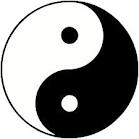 ve felt that they “lose the fire” for service after leaving Humanities I in Action. Is the solution for getting re-inspired about service going on more overseas trips? The lesson that I had not understood in all my years of focusing on social issues was the need to intentionally cultivate one’s heart in order to sustain a life of service. The yang of compassionate action needs to be complemented by the yin of inner awakening.
ve felt that they “lose the fire” for service after leaving Humanities I in Action. Is the solution for getting re-inspired about service going on more overseas trips? The lesson that I had not understood in all my years of focusing on social issues was the need to intentionally cultivate one’s heart in order to sustain a life of service. The yang of compassionate action needs to be complemented by the yin of inner awakening.
Ivy’s Reflection on her High School Career
The essay below was written by one of my students, Ivy, who tells the story of her own journey through this yin-yang process. Currently a university freshmen studying in the US, Ivy wrote this piece in December 2014 as she was completing my Service, Society, and the Sacred class. The essay prompt was simply for students to describe what they had learned in this class or throughout their high school career; Ivy chose the latter option.
As her teacher of these two courses that bookended her high school career, what is to be most celebrated is the natural transformation I witnessed in her four years at HKIS. In grade 9 Ivy was intelligent, precocious, and always very pleasant, but she tended to live in the abstract world of thought. Ideas were more interesting, it seemed, than daily life. However, when she graduated four years later, while still that highly intelligent young lady, she was far more grounded in her care for the local community, especially HKIS, and highly attuned to her own inner self development. Gratitude became a conscious pursuit in her final year as a senior, something she saw as vital for herself and our privileged school community.

At our end of the year final activity of the year in grade 9, the Heroic Journey. Ivy is in the lower left
“To Live” by Ivy Tse
I reflect back on my High School life with overwhelming emotions. Knowing that it’ll soon be time to move on, I am satisfied, optimistic, melancholic, and a little afraid. While I’m glad to have had experiences and met people that are important to me, this fulfillment is coupled with regret for missed opportunities. While I feel nostalgic for the giddy excitement of the past, I wait in eager anticipation for what’s to come. But above all, I’m grateful. Not only have I thoroughly enjoyed my time here, I’ve matured on many levels: the physical, intellectual, and spiritual. I’m even grateful for my conflicting emotions. Despite the confusion they create, being able to feel and accept so much indicates that I am “truly alive.”
My Humanities 1 in Action and Service, Society, and the Sacred courses have been integral in my process of internal and external awakening. Through Hums 1, I was exposed to the big problems of society, including genocide, eugenics, sex slavery in Thailand, and injustice at the cage dwellings literally in our backyard. Although it was disorienting, broadening and deepening my worldview as such allowed me to break out of the self-concerned bubble I had inadvertently trapped myself within. Hum 1 sparked in me a passion for service. In addition to opening my eyes to the world’s problems, the course fostered in me a genuine will to help. Studying our compassionate instinct gave me hope in combating the darker sides of our nature. Engaging in real-life service experiences proved that acts of compassion are both personally rewarding and powerful means of making positive change. In this way, I was freed from the unawareness and apathy associated with an underdeveloped social conscience.
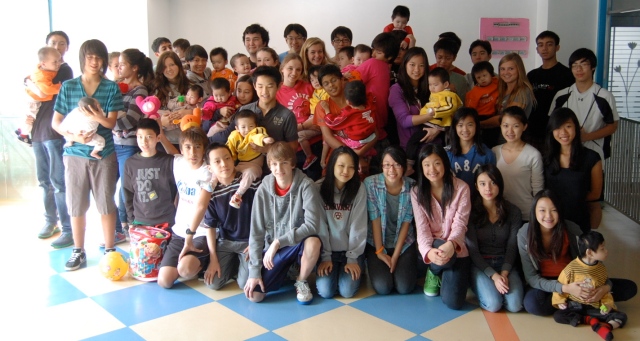
Our class trip to the Foshan Orphanage in China. Ivy is in the middle of the front row.
Yet, as I advanced to my sophomore and junior years of high school, our adventures in Hums 1 felt like a distant dream. Although I was aware of the shortcomings of operating from the “orange meme”, I found myself reverting back to the fast-paced, achievement-oriented lifestyle that is the norm at HKIS. The cultural influence of my family and community were just too overpowering. As I got older, I also became less idealistic. Trying not to disturb the status quo, I excused my inaction by thinking that I should live simply without making a fuss. This is not to say my insights and energy from Hums 1 stopped affecting me. My perspective of the world had been permanently imbued with color and the fire within me that seeks a greater purpose irreversibly ignited. But as I fell back to the rhythm of hectic teenager schedules, I felt like a robot again—practical and efficient, yet lacking a distinctly human quality.
Even my volunteer work with Kids4Kids became ritual-like. I enjoyed the service activities, but forgot why I dedicated myself to the organization in the first place and sometimes still struggle to now. It is especially difficult when I am assigned mundane or tedious tasks such as editing proposals, calculating profit, or labeling boxes. Such jobs changed my idealized perception of service. I realized that the necessary behind-the-scenes jobs are often uninviting and our impact indirect, slow, or barely noticeable. Only when we remember our purpose—to give something of ourselves for others—can we find meaning in the tasks at hand. I needed to get in touch with not just how I wanted to help others, but also why.

Ivy presenting her KidsforKids organization at the annual Service Summit as an upperclassman.
The problem for me is that I saw the world of Hums 1 in Action and the “real” world as separate and closed off from each other. Hums 1 had allowed me to visit a transcendental world through which I’ve completed my heroic journey. After I brought back my elixir through Kids4Kids advocacy, I didn’t know how to continue to channel my experiences into ordinary life, to transcend but include. SSS is the course that taught me how to do so.
SSS taught me to pay attention. I realized that in order to impact the larger world, we must deal with the immediate distractions at  home. After all, at the roots of big problems are often smaller ones that we can control. That’s why rather than attempting to end genocide, we should tackle our technology addiction, which arguably facilitates the lack of empathy that underlies evil. Likewise, in order to truly be of service to orphaned children, we need to strengthen our own filial relationships. In order to help others, we must first take care of ourselves.
home. After all, at the roots of big problems are often smaller ones that we can control. That’s why rather than attempting to end genocide, we should tackle our technology addiction, which arguably facilitates the lack of empathy that underlies evil. Likewise, in order to truly be of service to orphaned children, we need to strengthen our own filial relationships. In order to help others, we must first take care of ourselves.
As we explored issues relevant to our lives, I became more in tune with myself and my surroundings. I started paying attention to my mind, body, and spirit and to those of others. I notice my subtle bodily sensations. I notice when I deliver bad news through a technological medium instead of in person. I notice my emotion-driven behavior and the hours I spend cooped up at home instead of outside enjoying the fresh air. SSS provided a safe forum for me to discuss such topics that are otherwise taboo or ignored in the midst of our busy lives. This is valuable because not only are we intrigued, we care. We’ve all eaten “healthy foods” like tofu, most of us run on an excess of yang energy, and given the right circumstances, we’re all more or less susceptible to suicidal thoughts. It thus strikes me that why, if I don’t even attend to my basic well-being, of course it will be difficult to seek greater meaning.
In addition to paying attention, this course pushed me to open up. Both in and outside of class, I’ve shared personal stories that I had always kept to myself, such as the transformative experience that brought me closer to my dad. The communal nature of the course encouraged me: hearing my classmate’s stories or perspectives has exposed me to new outlooks or ensured me that others understand what I’ve been through. And because that’s been rewarding to me, I feel that in turn, I must share pieces of myself also. It delights me to have been able to open up as such. After all, in addition personal observation, I’ve found that collective reflections are key to making sense of our common experience—the experience of being human.
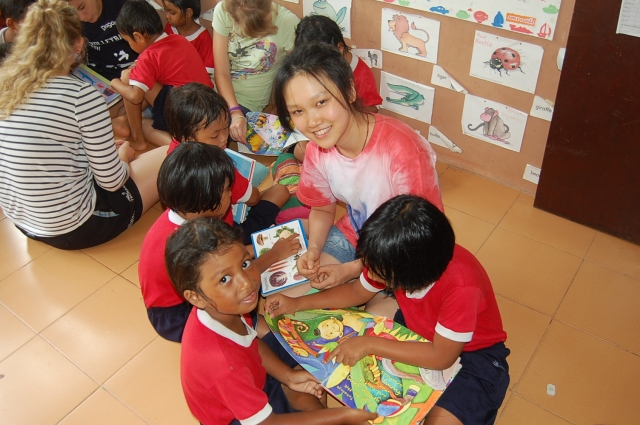
Ivy at Yaowawit School in March, 2012 where we spent a week joining this rural community about two hours drive from Phuket.Ivy, who speaks Thai, served as our trusty translator throughout our stay.
But the greatest value of the course lies in that after we recognize our situation, we’re empowered to initiate change. Narrowing our focus on issues closer to home has enabled me to take small, concrete steps to improve my life, in essence seeking micro-solutions to macro-problems. My efforts to make little changes have definitely had a positive impact, at least on a personal level. Increasingly, I initiate intimate conversations with others instead of hiding behind screens. I feel less guilty when I sing or take long walks, activities nourish my body and spirit but that I thought were “unproductive”. I keep my emotions in check, making a conscious effort not to think too much or behave rashly, such as lying on the bed idly when I’m stressed.
Our emphasis on spiritual practices especially helped me. The variety of activities we
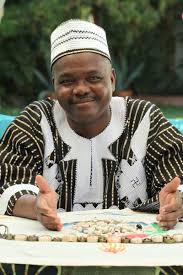
Ivy gave a speech as African healer Malidoma Some in a role-play.
engaged in during our Day of Soul set an uplifting mood that I still carry. It fascinates me that we all have something unique through which our souls enliven. In fact, the practices shared were of the same nature as the pottery, farming, and etc. activities Malidoma Somé calls “indigenous technologies”, through which he claims that we can harvest energy from the Other World. Bingo, I thought. This is the key to making something out my insights from Hums 1. Activating my inner dimension through regular spiritual practices will enable me to live the rest of my life meaningfully and with compassion. And while cultivating mindfulness requires at least as much focus, diligence, and consistency as bodybuilding, I know that it’s worth the effort.
There is no doubt that I had an incredible journey. Humanities 1 in Action challenged me to step outside my bubble and instilled in me a passion for service. SSS guided me in integrating that energy in a way that is cognizant of my immediate surroundings. As I work on my gratitude project and think about how to make the best out of my remaining time here, I feel myself radiate with life. Throughout my journey, I’ve learned how to live.

Final class photo for SSS class of 2014-2015 at Christmas time.
My Reflections on Ivy’s Essay
What I find most valuable in Ivy’s remarkable essay is her ability to integrate so many diverse experiences into a single journey. This is the challenge for all of us – to contain the chase of exponential growth in knowledge within one overarching narrative. She emerges from high school grateful for the knowledge of how to live – what could be called wisdom.
In more detail, I find these to be the most striking characteristics of her essay:
- The interrelationship of her physical, emotional, intellectual, and spiritual growth vis-à-vis the world.
- Waking up to world’s problems became linked in time to her personalized understanding of the human condition.
- The fundamental task of an early high school course, such as Humanities I in Action, is to awaken students to the sufferings of humankind.
- The fundamental task of a later high school course, such as Service, Society, and the Sacred, is to integrate students’ journey through high school by paying attention to the mind, body, and spirit.
- Service, Society, and the Sacred nourished her soul, restoring her sense of purpose regarding action in the world and energized her relationship with herself.
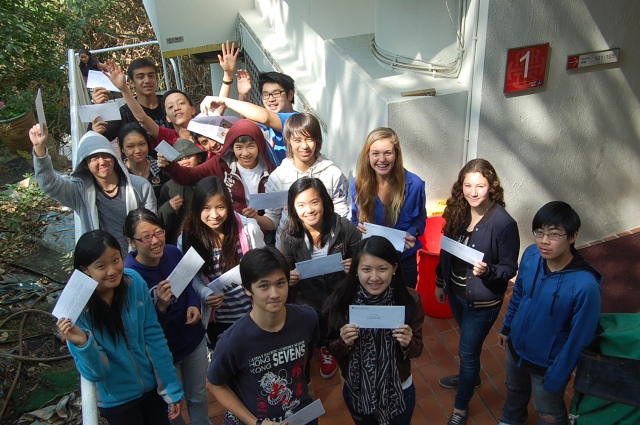
A letter-writing campaign in grade 9.
Seen through the lens of holistic education, Ivy’s essay is a model example of the kind of learning I would like to see in my classroom. Drawing from Miller’ s Whole Child Education (2010), her essay illustrates these characteristics of holistic education:
s Whole Child Education (2010), her essay illustrates these characteristics of holistic education:
- connectedness over fragmentation
- seeing the big picture of the world
- a sacredness of the inner soul as well as beyond the self
- purpose is implicit at all levels of the person and society
- transformation is evident
I also find Cohen and Wilber’s (2010) description of transformative growth as relevant to Ivy’s essay:
- increasing complexity that still holds together
- includes both waking up, which is often emotive and in the moment, and growing up, a structural and irreversible change in thinking
- a sense of a moral imperative
- dynamic sense of spirit-in-action in which a person acts in the horizontal (material) and vertical (spirit) dimensions of life
With these brief descriptors of holistic education in mind, enjoy the story of Ivy’s high school journey.
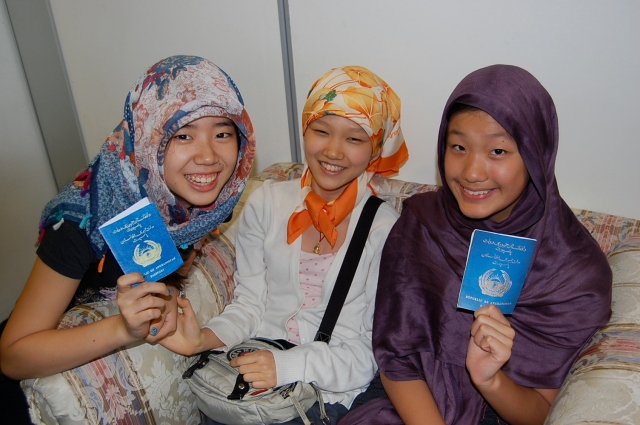
Ivy and her fellow grade 9 asylum seekers pose for a picture before embarking on Crossroads’ Refugee Run simulation.aption
Using Wilber’s AQAL Theory to Teach for Holistic Understanding
I feel that the place to start in teaching for holistic education is for teachers themselves to  see their curriculum through the lens of Ken Wilber’s AQAL (all-quadrants, all levels, all lines, all states, and all types) framework. All phenomena have aspects of all four quadrants, so the task for teachers is to reveal to students that every external behavior (upper right) has an internal subjective experience (UL), a cultural dimension (LL), and systemic impact on society (LR). Caring for a baby at an orphanage in China, for instance, can be explained as a subjective experience for both the student and the child (UL), involves Chinese and Western cultural issues (LL), and is a manifestation of Chinese population policies (LR). All of a sudden every action contains an array of complex associations.
see their curriculum through the lens of Ken Wilber’s AQAL (all-quadrants, all levels, all lines, all states, and all types) framework. All phenomena have aspects of all four quadrants, so the task for teachers is to reveal to students that every external behavior (upper right) has an internal subjective experience (UL), a cultural dimension (LL), and systemic impact on society (LR). Caring for a baby at an orphanage in China, for instance, can be explained as a subjective experience for both the student and the child (UL), involves Chinese and Western cultural issues (LL), and is a manifestation of Chinese population policies (LR). All of a sudden every action contains an array of complex associations.
I use the figure below to help make these connections more explicit:
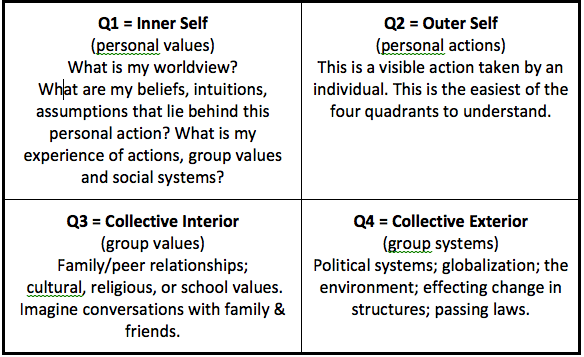
Seguing from the social to the personal, the exterior to the interior, the objective to the subjective, a group’s culture to the individual’s experience, etc, is an approach that students find eye-opening. When I can touch on all four quadrants in a single lesson, I feel confident that students are engaging in holistic learning, connecting their interior reflections to sociopolitical realities. In fact, it seems to me that this method of including all aspects of self and society in a curriculum honors the fullness of human experience that students find enlivening.
Conclusion
Ivy’s essay lends support to my intuition that this yin-yang approach genuinely meets the needs of students. Awakening younger students to the tangible suffering of others in the early years, and then teaching them to intentionally develop their own inner lives in their later years seems to be an effective curriculum sequence that matches the developmental trajectory of adolescents. Scholarship on holistic education, including Wilber’s AQAL theory, provides helpful descriptions of the outcomes of such an approach. Supported by this research, I believe that this kind of holistic curriculum results over time in students who find their study to be replete with meaning; and a few, like Ivy, sense that this form of education allows them to “radiate with life.”
References
Cohen, A & Wilber, K. (2010). “The Guru and the Pandit: Vertical and Horizontal Development,” Enlightenext, 46, Spring/Summer, 34-43.
Miller, J. (2010). Whole child education. Toronto: University of Toronto.
Additional Reading
- Ivy and a number of other students were interviewed by the South China Morning Post about the role of technology in their lives in the context of our study.
- Our SSS class offers their opinions about the impact of technology on their lives.
- Our debate about technology in which Ivy role-played Malidoma Some. Her summary of what he would say about technology is included here.
- For more about using Wilber’s AQAL theory in class, see this blog entry.


Thank you to Marty and Ivy for sharing reflections on this tremendous journey. The learning process, and the involvement with multiple dimensions of action, reflection, and holistic education, are so inspiring. You are exemplifying what education should help our students to do! Ivy, you are remarkable for sharing your experiences with others!
Pingback: “Recovering My Focus Towards Self-Love:” Final SSS Essay by Hollis Brown | Social Conscience and Inner Awakening